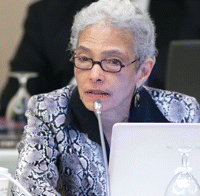At its March meeting in Arlington, Va., the APA Board of Trustees voted to approve several items related to the future of Psychiatric News. A work group appointed last year by then APA President Alan Schatzberg, M.D., and chaired by Jeffrey Borenstein, M.D., chair of APA's Council on Communications, was tasked with making recommendations about the future of APA's newspaper, in particular how it might expand to incorporate more digital options as readers get an increasing share of their professional and other information through those resources.
At last month's meeting the Board voted to support a move by
Psychiatric News to greatly expand its digital presence to complement the print version of the paper. The Board also approved a proposal to integrate APA's many newsletters into
Psychiatric News in tabbed sections of an expanded online edition of the paper that will soon be developed. (The online edition of
Psychiatric News is posted at <
pn.psychiatryonline.org>.) In addition, the Board approved funds for a redesign of the newspaper's print version that can be adapted for its digital products.
To give the paper's circulation a sizable boost that will make it more attractive to advertisers, some of whom have shifted their advertising to competing psychiatric publications with far more readers, the Board endorsed a proposal to send the paper to 10,000 nonmember psychiatrists. This will put its circulation on a par with those for the monthly publications Psychiatric Times and Clinical Psychiatry News and give APA an additional opportunity to convey information about its activities and accomplishments to nonmembers and in so doing interest them in joining APA.
APA President Carol Bernstein, M.D., agreed to appoint, in conjunction with President-elect John Oldham, M.D., a search committee that will recommend to the Board no later than September 1 the names of candidates for the next editor in chief of Psychiatric News. That position became vacant when James Krajeski, M.D., stepped down last May after 12 years in the job. Former APA President Carolyn Robinowitz, M.D., has been serving as interim editor in chief until Krajeski's successor is chosen.
Fellowship Criteria Change
On a membership-related issue, the Board decided to back a proposal from the Membership Committee to eliminate the requirement that APA members applying for fellowship status in the Association must have two letters of recommendation from current APA fellows. The other fellowship criteria will remain the same, that is, board certification, APA membership for at least five years, and a 30-day review by the applicant's district branch. The Board charged the Membership Committee with reviewing fellowship criteria again in two years to assess whether any additional revisions may be in order.
Minority-Trustee Election Procedures
Also on the Board's agenda last month was approving changes to APA Bylaws that are needed to reflect the Trustees' decision last year to add a minority/underrepresented (M/UR) group trustee and to reinstate an at-large trustee position.
Under the revised procedure, there will be an election for the trustee-at-large in the next election, which will be held in 2012. The first M/UR trustee will be elected in the following election cycle. Both the at-large trustee and the M/UR trustee will serve two-year terms.
Trustees also got an update on APA's activities concerning development of regulations to implement the federal parity law from Paul Wick, M.D., chair of the Board Work Group on Health Reform and Parity and a member of the Council on Healthcare Systems and Financing. Wick noted that the group is focusing on both "general issues of significance," such as the scope of services health plans have to provide under the law, and "specific issues that directly impact psychiatry," for example, reimbursement rates for psychiatrist-provided services.
In the next six to nine months, the work group, along with the Council on Healthcare Systems and Financing, will concentrate on how the parity law requirements apply to managed Medicaid plans and on what mental health services must be included in the "essential health benefit package" that health plans offer so that they comply with the parity law. The work group will also address with federal regulators "undue utilization review requirements for inpatient and outpatient care," Wick noted.
On another matter, the Board voted to give $50,000 in American Psychiatric Foundation funds to help sponsor the "Next Frontier, One Mind for Brain Research" campaign, which is being spearheaded by former Rep. Patrick Kennedy and has a goal of raising $1 billion for research into brain disorders (see next issue).



